 W
WThe African blue tit is a species of bird in the family Paridae. It is found in northern Africa and the Canary Islands. Its natural habitat is temperate forests. This species and the Eurasian blue tit were formerly considered conspecific. The status of this species has not been assessed because it is noted to be common on the islands of Tenerife and Gran Canaria. The species has been used in many research studies due to its island populations and relevance to evolutionary hypotheses.
 W
WThe African giant shrew is a species of white-toothed shrew. It also is known as, Mann's musk shrew, Euchareena's musk shrew, or Olivier's shrew. It is native to Africa, where it has a widespread distribution and occurs in many types of habitat. Its natural habitats are subtropical or tropical dry forest, subtropical or tropical moist lowland forest, subtropical or tropical moist montane forest, dry savanna, moist savanna, arable land, rural gardens, urban areas, and heavily degraded former forest. In the Nile Valley it is found near human habitation, where it is considered to be a pest. It is a common species and is listed by the International Union for Conservation of Nature as being of "least concern".
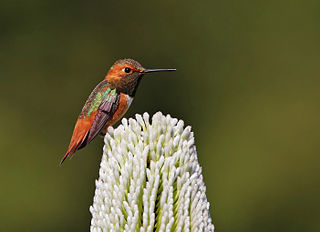 W
WAllen's hummingbird is a species of hummingbird. It is a small bird, with mature adults reaching only 3 to 3.5 in in length. The male has a green back and forehead, with rust-colored (rufous) flanks, rump, and tail. The male's throat is an iridescent orange-red. The female and immature Allen's hummingbirds are similarly colored, but lack the iridescent throat patch, instead having a series of speckles on their throats. Females are mostly green, featuring rufous color only on the tail, which also has white tips. Immature Allen's hummingbirds are so similar to the female rufous hummingbird, the two are almost indistinguishable in the field. Both species' breeding seasons and ranges are common factors used to differentiate between the two species in a particular geographical area.
 W
WAnna's hummingbird is a medium-sized bird species of the family Trochilidae. It was named after Anna Masséna, Duchess of Rivoli.
 W
WAonyx is a genus of otters, containing three species, the African clawless otter, the Congo clawless otter, and the Asian small-clawed otter. The word aonyx means "clawless", derived from the prefix a- ("without") and onyx ("claw/hoof").
 W
WArctocephalus forsteri is a species of fur seal found mainly around southern Australia and New Zealand. The name New Zealand fur seal is used by English speakers in New Zealand; kekeno is used in the Māori language. As of 2014, the common name long-nosed fur seal has been proposed for the population of seals inhabiting Australia.
 W
WArvicanthis is a genus of rodent from Africa. They are commonly referred to as unstriped grass mice, unstriped grass rats, and kusu rats.
 W
WThe olive baboon, also called the Anubis baboon, is a member of the family Cercopithecidae. The species is the most wide-ranging of all baboons, being found in 25 countries throughout Africa, extending from Mali eastward to Ethiopia and Tanzania. Isolated populations are also present in some mountainous regions of the Sahara. It inhabits savannahs, steppes, and forests. The common name is derived from its coat colour, which is a shade of green-grey at a distance. A variety of communications, vocal and non-vocal, facilitate a complex social structure.
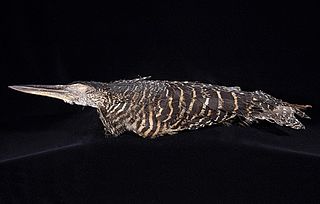 W
WThe forest bittern is a bird indigenous to New Guinea. It is the only member of the genus Zonerodius and is also known as the New Guinea tiger heron.
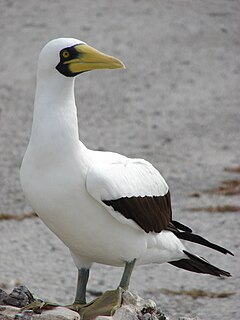 W
WThe masked booby, also called the masked gannet or the blue-faced booby, is a large seabird of the booby and gannet family, Sulidae. First described by the French naturalist René-Primevère Lesson in 1831, the masked booby is one of six species of booby in the genus Sula. It has a typical sulid body shape, with a long pointed yellowish bill, long neck, aerodynamic body, long slender wings and pointed tail. The adult is bright white with black wings, a black tail and a dark face mask; at 75–85 cm (30–33 in) long, it is the largest species of booby. The sexes have similar plumage. This species ranges across tropical oceans, except in the eastern Atlantic and eastern Pacific. In the latter, it is replaced by the Nazca booby, which was formerly regarded as a subspecies of masked booby.
 W
WUakari is the common name for the New World monkeys of the genus Cacajao. Both the English and scientific names are believed to have originated from indigenous languages.
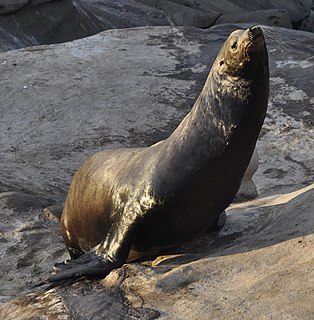 W
WThe California sea lion is a coastal eared seal native to western North America. It is one of six species of sea lion. Its natural habitat ranges from southeast Alaska to central Mexico, including the Gulf of California. California sea lions are sexually dimorphic; males are larger than females, and have a thicker neck, and protruding sagittal crest. They mainly haul-out on sandy or rocky beaches, but they also frequent manmade environments such as marinas and wharves. Sea lions feed on a number of species of fish and squid, and are preyed on by killer whales and great white sharks.
 W
WThe bearded sakis, or cuxiús are five species of New World monkeys, classified in the genus Chiropotes. They live in the eastern and central Amazon in South America, ranging through southern Venezuela, Guyana, Suriname, French Guiana and northern and central Brazil. The five species are entirely allopatric, their distributions being separated by major rivers.
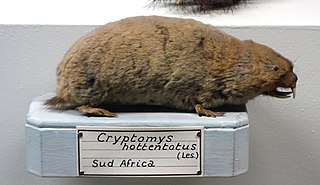 W
WThe common mole-rat, African mole-rat, or Hottentot mole-rat, is a burrowing rodent found in Southern Africa, in particular in the Western Cape province of South Africa. It also occurs in Lesotho, Malawi, Mozambique, Swaziland, Tanzania, Zambia, and Zimbabwe. It is a species in the subfamily Bathyerginae.
 W
WThe double-crested cormorant is a member of the cormorant family of water birds. Its habitat is near rivers and lakes as well as in coastal areas, and is widely distributed across North America, from the Aleutian Islands in Alaska down to Florida and Mexico. Measuring 70–90 cm (28–35 in) in length, it is an all-black bird which gains a small double crest of black and white feathers in breeding season. It has a bare patch of orange-yellow facial skin. Five subspecies are recognized. It mainly eats fish and hunts by swimming and diving. Its feathers, like those of all cormorants, are not waterproof and it must spend time drying them out after spending time in the water. Once threatened by the use of DDT, the numbers of this bird have increased markedly in recent years.
 W
WA tuco-tuco is a neotropical rodent in the family Ctenomyidae. Tuco-tucos belong to the only living genus of the family Ctenomyidae, Ctenomys, but they include approximately 60 different species. The common name, "tuco-tuco" comes from the "tuc-tuc" sound they make while they dig their burrows.
 W
WCurrawongs are three species of medium-sized passerine birds belonging to the genus Strepera in the family Artamidae native to Australia. These are the grey currawong, pied currawong, and black currawong. The common name comes from the call of the familiar pied currawong of eastern Australia and is onomatopoeic. They were formerly known as crow-shrikes or bell-magpies. Despite their resemblance to crows and ravens, they are only distantly related to the corvidae, instead belonging to an Afro-Asian radiation of birds of superfamily Malaconotoidea.
 W
WEmoia atrocostata, commonly known as the littoral whiptail-skink, mangrove skink, or littoral skink, is a species of lizard in the family Scincidae. It inhabits mangroves, back-beach vegetation and rocky shorelines. It is semi-aquatic and forages in tidal pools.
 W
WEmoia cyanura, the copper-tailed skink, is a species of skink. It is found in Borneo and South Pacific islands.
 W
WEuphlyctis hexadactylus, also known as the green pond frog, Indian green frog, and Indian five-fingered frog, is a common species of aquatic frog found in Pakistan, India, Bangladesh, and Sri Lanka. The nominal taxon likely represents a species complex.
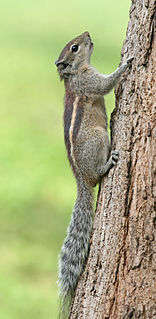 W
WFunambulus is a genus of rodents in the Sciuridae (squirrel) family. It contains these species:Genus Funambulus Subgenus Funambulus Layard's palm squirrel Indian palm squirrel Nilgiri striped palm squirrel Dusky palm squirrel Jungle palm squirrel Subgenus Prasadsciurus Northern palm squirrel
 W
WGarrulax is a genus of passerine birds in the family Leiothrichidae.
 W
WPilot whales are cetaceans belonging to the genus Globicephala. The two extant species are the long-finned pilot whale and the short-finned pilot whale. The two are not readily distinguishable at sea, and analysis of the skulls is the best way to distinguish between the species. Between the two species, they range nearly worldwide, with long-finned pilot whales living in colder waters and short-finned pilot whales living in tropical and subtropical waters. Pilot whales are among the largest of the oceanic dolphins, exceeded in size only by the killer whale. They and other large members of the dolphin family are also known as blackfish.
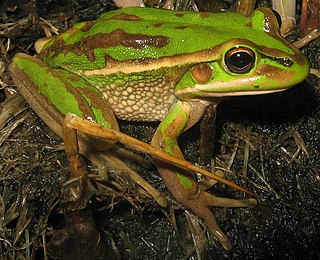 W
WThe green and golden bell frog, also named the green bell frog, green and golden swamp frog and green frog, is a ground-dwelling tree frog native to eastern Australia. Despite its classification and climbing abilities, it does not live in trees and spends almost all of its time close to ground level. It can reach up to 11 cm (4.5 in) in length, making it one of Australia's largest frogs.
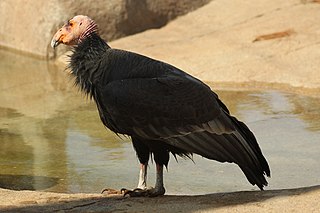 W
WGymnogyps is a genus of New World vultures in the family Cathartidae. There are five known species in the genus, with only one being extant, the California condor.
 W
WHolothuria edulis, commonly known as the edible sea cucumber or the pink and black sea cucumber, is a species of echinoderm in the family Holothuriidae. It was placed in the subgenus Halodeima by Pearson in 1914, making its full scientific name Holothuria (Halodeima) edulis. It is found in shallow water in the tropical Indo-Pacific Ocean.
 W
WHolothuria hilla is a species of sea cucumber in the subgenus Mertensiothuria of the genus Holothuria. Some common names include the contractile sea cucumber, the sand sifting sea cucumber and the tigertail sea cucumber, and in Hawaii it is known as the light spotted sea cucumber. It is found in the Indo-Pacific region and the Red Sea.
 W
WThe Inca dove or Mexican dove is a small New World dove. The species was first described by French surgeon and naturalist René Lesson in 1847. It reaches a length of 16.5–23 cm (6.5–9.1 in) and weighs 30–58 g (1.1–2.0 oz). The Inca dove has an average wingspan of 28.5 cm and a max wingspan of 32 cm. It is a slender species, with a gray-brown body covered in feathers that resemble a scaled pattern. The tail is long and square and edged with white feathers that may flare out in flight. The underwings are reddish, like other ground doves, and upon takeoff, the wings produce a distinctive, quiet rattling noise.
 W
WThe emerald tree skink, sometimes (ambiguously) known as "green tree skink" or "emerald green skink". It is a non-threatened species although it not commonly seen but it is however, becoming more and more popular in the exotic pet trade. In the Philippines, it is called Tabili in the Cebuano vernacular.
 W
WThe four species of lion tamarins make up the genus Leontopithecus. They are small New World monkeys named for the mane surrounding their face, similar to the mane of a lion.
 W
WThe moth skink is a species of skink. It is found in Pacific regions including Sulawesi, Northern Papua New Guinea, Solomon Islands, Vanuatu, Tuamotu, Marquesas Islands, Pitcairn Islands, Hawaii, Indonesia, Fiji, Western Samoa, Admiralty Islands, Bismarck Archipelago, Tonga, Toga, Tegua, Cook Islands and Guam.
 W
WThe marabou stork is a large wading bird in the stork family Ciconiidae. It breeds in Africa south of the Sahara, in both wet and arid habitats, often near human habitation, especially landfill sites. It is sometimes called the "undertaker bird" due to its shape from behind: cloak-like wings and back, skinny white legs, and sometimes a large white mass of "hair".
 W
WThe megapodes, also known as incubator birds or mound-builders, are stocky, medium-large, chicken-like birds with small heads and large feet in the family Megapodiidae. Their name literally means "large foot" and is a reference to the heavy legs and feet typical of these terrestrial birds. All are browsers, and all but the malleefowl occupy wooded habitats. Most are brown or black in color. Megapodes are superprecocial, hatching from their eggs in the most mature condition of any bird. They hatch with open eyes, bodily coordination and strength, full wing feathers, and downy body feathers, and are able to run, pursue prey, and in some species, fly on the same day they hatch.
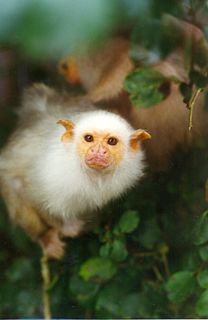 W
WMico is a genus of New World monkeys of the family Callitrichidae, the family containing marmosets and tamarins. The genus was formerly considered a subgenus of the genus Callithrix.
 W
WThe golden monarch is a species of passerine bird in the family Monarchidae found in New Guinea. Its natural habitats are subtropical or tropical moist lowland forests and subtropical or tropical moist montane forest. The golden monarch displays marked sexual dimorphism, the male a striking golden colour with black mask, wings and tail, the female a golden or golden-olive colour. Both bear a characteristic 'teardrop' white pattern below the eye.
 W
WMops is a genus of bats in the family Molossidae. Molecular sequence data indicates that Mops and Chaerephon are not monophyletic taxa. However, the grouping of Chaerephon minus C. jobimena plus Mops was found to be monophyletic.
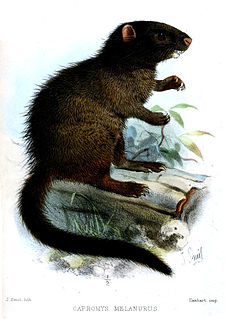 W
WMysateles is a genus of rodent in the family Capromyidae. The genus is restricted to Cuba.
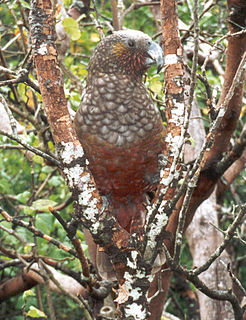 W
WThe genus Nestor is the type and only extant genus of the parrot family Nestoridae. Together with the kakapo, and the extinct parrots in the genus Nelepsittacus, they form the parrot superfamily Strigopoidea. The genus Nestor contains two extant parrot species from New Zealand and two extinct species from Norfolk Island and Chatham Island, New Zealand, respectively. All species are large stocky birds with short squarish tails. A defining characteristic of the genus is the tongue, which is tipped with a hair-like fringe. The superficial resemblance of this tongue to that of lorikeets has led some taxonomists to consider the two groups closely related, but DNA evidence shows they are not.
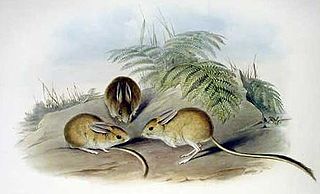 W
WA hopping mouse is any of about ten different Australian native mice in the genus Notomys. They are rodents, not marsupials, and their ancestors are thought to have arrived from Asia about 5 million years ago.
 W
WThe Indian nuthatch is a species of bird in the family Sittidae. It is found in Bangladesh, India and Nepal.
 W
WAudubon's oriole, formerly known as the black-headed oriole, is a New World passerine inhabiting the forests and thickets of southeastern Texas and the Mexican coast. It is the only species to have a black hood and yellow body. It is divided into four subspecies and two allopatric breeding ranges. The westernmost range extends from Nayarit south to southern Oaxaca, whereas the eastern range stretches from the lower Rio Grande valley to northern Querétaro. The most common in the western range are the subspecies I. g. dickeyae and I. g. nayaritensis; I. g. graduacauda and I. g. audubonii can be found in the eastern range. Like most Central American birds, it is not a migratory species and does not display significant sexual dimorphism. DNA analysis of the ND2 and cyt-b genes strongly suggests that I. graduacauda is most closely related to I. chrysater, the yellow-backed oriole. It is a member of the genus Icterus and therefore should not be confused with the Old World orioles.
 W
WFish owls form a group of owls in the family Strigidae. Ketupa was proposed as generic name by René-Primevère Lesson in 1831 for fish owl species from Java and India. Results of a phylogenetic analysis of nine horned owl species indicate that Ketupa species form a monophyletic group. Ketupa is therefore thought to merit subgeneric rank comprising the following species:Brown fish owl described by Johann Friedrich Gmelin in 1788 was a fish owl from Sri Lanka; Buffy fish owl described by Thomas Horsfield in 1821 was a fish owl from Java; Tawny fish owl described by Brian Houghton Hodgson in 1836 was a fish owl from Nepal.
 W
WPapurana papua is a species of true frog, family Ranidae. It is endemic to New Guinea and found in the northern part of the island in both Indonesia and Papua New Guinea as well in some offshore islands. Common name Papua frog has been coined for it.
 W
WThe Palawan peacock-pheasant is a medium-sized bird in the family Phasianidae.
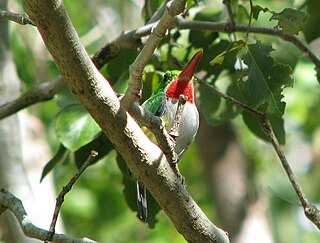 W
WThe Puerto Rican tody is a bird native to the island of Puerto Rico. Despite its scientific name, the Puerto Rican tody is endemic to the island and is locally known as "San Pedrito".
 W
WRafinesque's big-eared bat, sometimes known as the southeastern big-eared bat, is a species of vesper bat native to the southeastern United States.
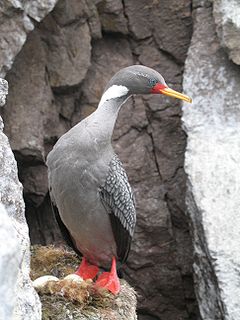 W
WThe red-legged cormorant also known as the red-legged shag, red-footed cormorant, red-footed shag, Gaimard's cormorant and grey cormorant, is a resident of the coastline of South America. It is non-colonial unlike most seabirds. The red-legged cormorant has not been observed wing-spreading, which is unusual among cormorant species.
 W
WThe greater roadrunner is a long-legged bird in the cuckoo family, Cuculidae, from the Aridoamerica region in the Southwestern United States and Mexico. The scientific name means "Californian earth-cuckoo". Along with the lesser roadrunner, it is one of two species in the genus Geococcyx. This roadrunner is also known as the chaparral cock, ground cuckoo, and snake killer.
 W
WHumboldt's squirrel monkey is a species of squirrel monkey from Brazil, Colombia, Ecuador, Peru and Venezuela. It had previously been considered a subspecies of the common squirrel monkey, S. scuireus, but was elevated to full species status based on a genetic study by Carretero-Pinzón in 2009. A genetic study by Jessica Lynch Alfaro, et al indicated that the Ecuadorian squirrel monkey may be synonymous with Saimiri cassiquiarensis. As of 2018, the Ecuadorian squirrel monkey is generally regarded as a subspecies of Humboldt's squirrel monkey, S. cassiquiarensis macrodon.
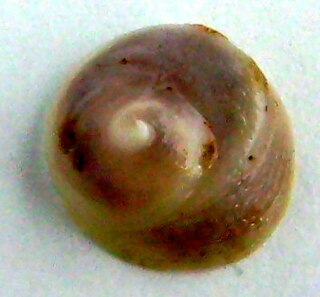 W
WSigapatella is a genus of small to medium-sized sea snails, marine gastropod molluscs in the family Calyptraeidae, the slipper snails, Chinese hat snails, and cup-and-saucer snails.
 W
WSigapatella novaezelandiae, common name the circular slipper limpet, is a species of medium-sized sea snail, a marine gastropod molluscs in the family Calyptraeidae.
 W
WThe slaty bristlefront is a member of the tapaculos, the Neotropical bird family Rhinocryptidae.
 W
WThe brushtail possums are the members of the genus Trichosurus in the Phalangeridae, a family of marsupials. They are native to Australia and some small nearby islands. Unique among marsupials, they have shifted the hypaxial muscles from the epipubic to the pelvis, much like in placental muscles, meaning that their breathing cycle is more similar to the latter than to that of other non-eutherian mammals. In general, they are more terrestrially oriented than other possums, and in some ways might parallel primates.
 W
WTriodon macropterus, also known as the threetooth puffer, is a tetraodontiform fish, the only living species in the genus Triodon and family Triodontidae. Other members of the family are known from fossils stretching back to the Eocene.
 W
WVicugna is a genus containing two South American camelids, the vicuña and the alpaca.
 W
WThe Weddell seal is a relatively large and abundant true seal with a circumpolar distribution surrounding Antarctica. The Weddell seal was discovered and named in the 1820s during expeditions led by British sealing captain James Weddell to the area of the Southern Ocean now known as the Weddell Sea. The life history of this species is well documented since it occupies fast ice environments close to the Antarctic continent and often adjacent to Antarctic bases.
 W
WThe yellow-naped amazon or yellow-naped parrot is an endangered amazon parrot sometimes considered to be a subspecies of the yellow-crowned amazon.
 W
WThe California sea lion is a coastal eared seal native to western North America. It is one of six species of sea lion. Its natural habitat ranges from southeast Alaska to central Mexico, including the Gulf of California. California sea lions are sexually dimorphic; males are larger than females, and have a thicker neck, and protruding sagittal crest. They mainly haul-out on sandy or rocky beaches, but they also frequent manmade environments such as marinas and wharves. Sea lions feed on a number of species of fish and squid, and are preyed on by killer whales and great white sharks.